| |
ICHARM NEWSLETTER
International Centre for Water Hazard
and Risk Management under the auspices of UNESCO
Vol.2-No.1
March, 2007 | |
In our periodical newsletter, we continue
our focus on providing our national and international partners and colleagues
with up-to-date information on the progress of our activities at ICHARM. (Click
here for back numbers of UNESCO-PWRI
newsletters) |
1.
Message from the Director
The first meeting of the Management Committee
and Advisory Committee of the International Flood Initiative (IFI) was held on
26 January 2007 at WMO, Geneva. The draft plan of the IFI was officially adopted
and ICHARM started to work as the secretariat of the IFI. It is an honour for
us to serve for the IFI activities while feeling a heavy responsibility. It was
a long waited meeting since the official launch of the IFI by UNESCO, WMO, ISDR
and UNU at the occasion of the UN World Conference on Disaster Reduction (WCDR)
in Kobe, January 2005. The Geneva meeting was attended by all the Management Committee
members and the major Advisory Committee members, chaired by Bruce Stewart, the
Chairperson of Commission of Hydrology, WMO. The mission statement of IFI
reads that "The International Flood Initiative promotes an integrated approach
to flood management, at the same time, reducing social, environmental and economic
risks that result in and from floods and increasing the benefits from floods and
the use of flood plains." It aims to integrate land and water resources development,
including the institutional components of flood management, and promote stakeholder
participation and cultural diversity. The overall objective of IFI is to build
capacities in countries to gain and advocate better understanding and handling
of hazards, vulnerabilities and benefits of floods by the following guiding principles:
Living with Floods; Equity; Empowered participation; Inter-disciplinarity and
trans-sectorality; and International and regional cooperation. Those objectives
and principles of IFI well echo with those of ICHARM. It is our great pleasure
to work with many partners sharing the common aims of the IFI. Some concrete commitments
were expressed by each partner during the meeting. Among others, ICHARM proposed
an idea emerged during the discussion with Japan Water Forum, that is, a concept
of "International Standards" that each community may be suggested to
prepare for emergency responses to avoid any unexpected extraordinary consequences
due to floods. Such standards may serve as an indicator to count the number of
communities that become prepared for flood events and monitor the progress of
societal preparedness against disasters that can be set as a numerical target
and continuously reviewed by World Water Development Report. Another important
commitment ICHARM announced in the meeting was the launch of the Disaster Mitigation
Master Course in October 2007 jointly organized with National Graduate Institute
for Policy Studies (GRIPS) in the framework of JICA training program. It is a
one-year course leading to the Master's Degree on flood management. A limited
number of scholarship awardees will be selected on competitive basis by JICA to
which ICHARM expresses its deep appreciation. This is a practice oriented master
course targeted to the young professionals working in the operational fields of
land and water management. We expect enthusiastic practitioners to join the course
from various countries in the world. 
Dr. Kuniyoshi
Takeuchi
Director of ICHARM
|
2.
Recruiting 6 new specialty researchers
ICHARM is now internationally
recruiting 6 specialty researchers who can start working from July 2007. Related
information can be seen at the following adress. >> detail information |
| |
3. Field Survey
in Thailand and Cambodia (2006 Dec.10-15, Thailand/Cambodia)
In order
to examine the current flood related problems thereby to conduct need assessment
of flood hazard mapping, ICHARM has conducted a field survey in Thailand and Cambodia
during 10th to 15th December, 2006. In Thailand, 32 provinces were severely attacked
by floods this year (2006), leaving 164 people dead and affecting more than 2
million people. In Cambodia, flood caused not extreme damages like in the past,
however prolonged turmoil paralyzed the normal life in most flood prone communities.
Pursat and Kampong Cham provinces in Cambodia were among the affected areas, where
some people also lost their lives. The main target of this field visit
was to collect flood hazard mapping related information through interviews and
site inspections, so that the best practicable strategy can be recommended to
promote flood hazard mapping in each country. In addition, gathered information
is expected to be helpful in developing flood hazard mapping manual for each country.
Since the flooding season in this region especially in visited countries lasts
in November, the field survey was planned accordingly to match the timing to observe
the impact and to collect the damage information of the year. The survey team
of ICHARM included 2 members (Dr. Osti and Mr.Tokioka). In Thailand, the team
interviewed some engineers in central and regional Royal Irrigation Departments
(RID) and visited Sonkhla province and Hat Yai city in the south. In Cambodia,
the team interviewed concerned managers at Department of Hydrology and River Works
(DHRW) and visited Pre-Veng and Pursat provinces. Click here
for detail survey report. | | |
4. "The
3rd US-Japan Conference on Flood Control and Water Resources Management"(Jan.28-29,
USA)
The 3rd US-Japan Conference on Flood Control and Water Resources
management was held in New Orleans on 9th January. Mr. Terakawa, Acting Director
of ICHARM, participated in the conference as a member of Japanese delegation headed
by Mr. Kadomatsu, Director General of the River Bureau of the Ministry of Land,
Infrastructure and Transport (MLIT). The annual conference is alternately hosted
by US Army Corps of Engineers (USACE) and MLIT, based on the implementation arrangement
between both organizations, which was signed during the Third World Water Forum
in Japan in March 2003. As one of the speakers from both sides, Mr. Terakawa made
a presentation entitled 'Toward integrated flood risk management - Outline of
ICHARM', in which he explained the background and recent activities of ICHARM
aiming at functioning to provide and assist implementation of the best practicable
strategies for preventing and mitigating water related disasters in the world.
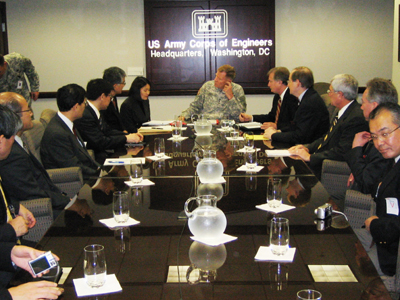
Courtesy visit to Dr. Strock, Commander of USACE |
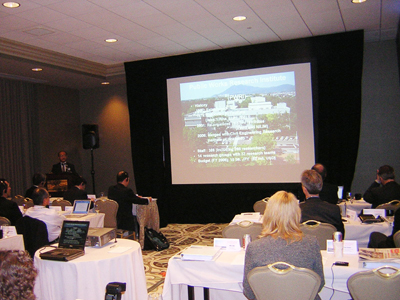
There were 9 presentations form both sides on risk management, environmental impact,
consensus building and watershed management. | |
| |
5."The
2nd Asian Water Cycle Symposium (AWCS)" in the University of Tokyo (Jan.9-10,
Tokyo, Japan)
This Symposium has reviewed and discussed a baseline
implementation plan of the Demonstration Projects and respective proposals mainly
for the nominated river basins in individual countries. Key local water resources
issues, existing observation capability, and data availability were among other
topics of discussion. In this symposium, participants discussed the possibilities
of effective collaboration among local/national water resources management as
well as meteorological authorities and institutions, international organisations
and programmes, and space agencies. This kind of collaboration is essential for
the successful implementation of Demonstration Projects and ensuing AWCI activities.
Mr. Fukami, a leader of Hydrologic Engineering Research Team participated and
introduced an information network and training activities of ICHARM.
| | |
6. International Symposium on 2006 Flood of Chao Phraya River: "Emerging
issues and contribution of hydrological studies" (Jan.19, Thailand)
The International Symposium on 2006
Flood of Chao Phraya River: "Emerging Issues and Contribution of Hydrological
Studies" was held on 19th January , 2007, at the Royal River Hotel on the
Chao Phraya River in Thailand. The symposium was organized by the Thai National
Committee on Irrigation and Drainage, the Public Works Research Institute (PWRI),
and the Disaster Prevention Research Institute of Kyoto University with support
from the Japan Science and Technology Agency. The Chao Phraya River was flooded
for about four months from September through December 2006, which has brought
our attention to emerging flood-related issues. The symposium provided an opportunity
to discuss ways to apply research results produced by the Core Research for Evolutional
Science and Technology (CREST) project and other projects to those issues in terms
of the relationship between the basin's socio-economic development and water cycle. The
main purpose of this symposium was to present the results of a PWRI research project
entitled "Interactions between Social Changes and Water Cycle in the Chao
Phraya River Basin" to scientists and government engineers in Thailand. The
research project is part of "System Modeling Approaches for Assessment of
Interaction between Social Changes and Water Cycle" led by Prof. Kaoru Takara
of Kyoto University. This is, in turn, one of the research topics of a CREST program
called "Research and Development of Hydrological System Modeling and Water
Resources System." The symposium participants exchanged information regarding
the damage caused by the 2006 flood and emerging flood-related issues by communicating
in Japanese or Thai through simultaneous interpretation.
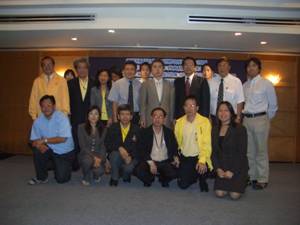
Organizers and participants at the symposium |
|
| |
7.
"The 8th USGS-NILIM/PWRI Workshop on Hydrology and Water Resource "
(Jan.28-29, USA)
The Public Works Research Institute, the National
Institute for Land and Infrastructure Management (NILIM), and the United States
Geological Survey (USGS) had jointly organized a workshop, which was held from
28th to 29th January in Denver, Colorado USA. Representatives from each organization
discussed the direction and the contents of potential collaborative researches.
Acting Director of ICHARM, Mr. Terakawa reported the activities of ICHARM and
highlighted the possible cooperation between ICHARM and USGS. The team
leader of Hydrologic Engineering Research Team, Mr. Fukami also attended this
workshop to exchange information and research results, activities on discharge
observation technology development, and flood forecasting technology with USGS.
He also joined a discussion with USGS about the nfluence of climate change to
hydrology and water resources. On 2nd February, they visited USGS office at the
University of Sacramento in California and shared information about water resources
and water environment management in the state of California.
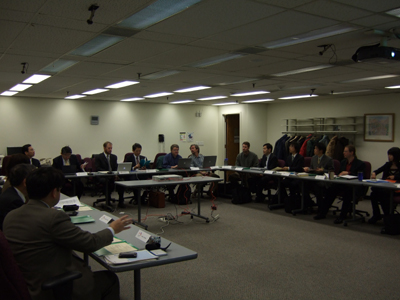
at the workshop | | |
|
8.
"The 3rd Workshop on Watershed and River System Management" (Jan.31,
USA) 8**This workshop was jointly organized by Bureau of Reclamation,
U.S. Department of the Interior (USBR) and the Public Works Research Institute
on 31st January in Denver Colorado, U.S.A. The Public Works Research Institute
and USBR have established an agreement for 'Collaborative research on watershed
and river system management' in 2002. Mr. Kuriki, Executive Coordinator for International
Affairs, and Mr. Fukami, the leader of Hydrologic Engineering Research Team attainted
this workshop and exchanged research activities and results on watershed management
planning that were part of research topics of the agreement. They agreed to enhance
the exchange of information on hydrological statistics, database system of river
information and United States water resources management initiative 'Water 2025'.
The workshop was followed by field trip to water resources facilities in San Francisco,
California.**8
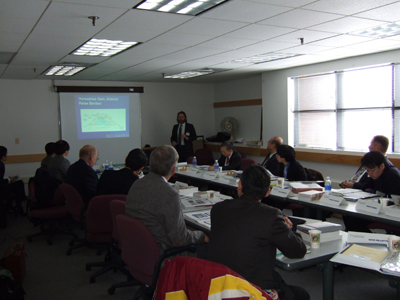
at the workshop | | |
|
9.
Mangrove Survey in Malaysia (Feb.3, Malaysia)
ICHARM has just started
to study seacoast vegetation as a possible tsunami disaster prevention measure
which is sustainable. The study includes a plan to explore possible ways to use
seacoast vegetation, such as mangroves, for seacoast preservation. Although mangrove
forests have not been paid close attention by developing countries in general,
the forests are considered to play a very important role in tsunami disaster prevention
in some developing countries. For example, right after the Great Indian Ocean
Tsunami induced by the Sumatra Earthquake, the Malaysian prime minister said coastal
projects should be planned so that mangrove trees were not harmed and ordered
government agencies to replant mangrove trees felled by last month's devastating
tsunami. Last November, an international symposium on mangrove management
was held at Kyoto under the leadership of Prof. Kiyoshi Kobayashi of Kyoto University.
The symposium was a great opportunity for participants to exchange a great deal
of information on mangroves from different viewpoints, including ecology, environment,
disaster prevention, sight-seeing, and management. The second international symposium
on mangrove management is scheduled for September this year. To look at
the current state of mangrove forests more closely, Prof. Kobayashi and Mr. Tanaka,
an ICHARM senior researcher, visited Malaysia on 3rd February to conduct a joint
on-sight survey on mangrove forests in the Carey Island, which is located off
the western coast of Malaysia and about an hour's drive from Kuala Lumpur. Dr.
Maisarah Ali, a deputy dean of the International Islamic University Malaysia,
kindly offered to be a local guide for us. Picture 1 shows
a kind of mangrove whose leaves excrete salt, which has been taken into its system.
You can taste salt by licking those leaves. Picture 2 shows a nest hole
dug by crabs living in mangrove forests. They created a tiny silt mound, about
30cm high.
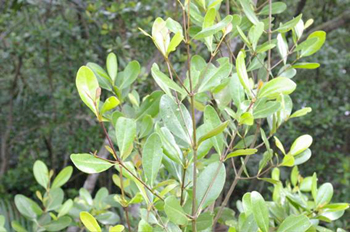
Picture 1 Mangrove with salt-excreting leaves | 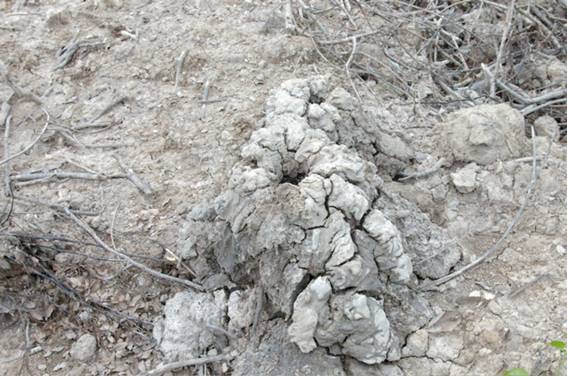
Picture 2 Nest hole by crabs living in mangrove forests | Picture
3 shows mangroves cut down for charcoal use. Those were relatively thin trees
of about 10cm in diameter. There were mangrove seedlings ready to plant beside
the cut-down trees.
Picture 4 shows a mangrove seed, which looks like it
is sticking into the ground after dropping from a tree.
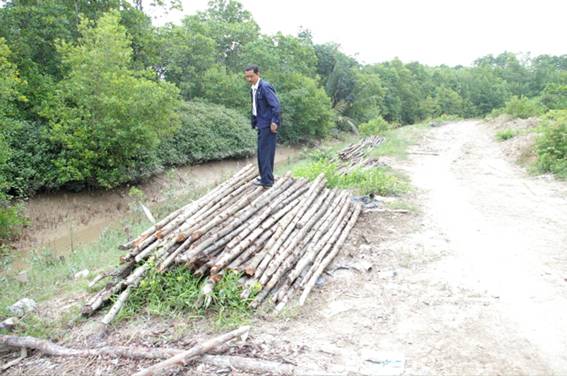
Picture 3 Mangrove trees cut down for charcoal use |
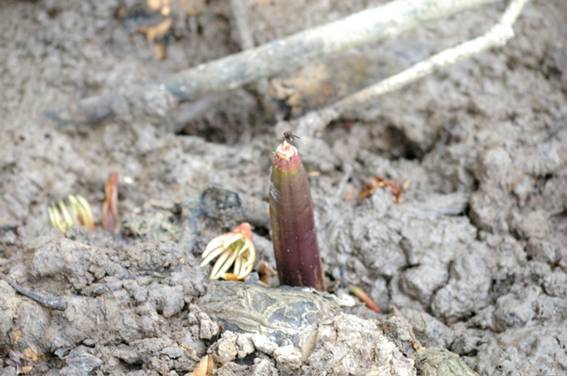
Picture 4 Mangrove seed sticking into the ground | |
| |
10. A Brief
Survey on Flood Damage Assessment Conducted in Johore State, Malaysia (Feb.5-6,
Malaysia) 10**In two separate incidents on December, 2006 and January,
2007, southern part of Malaysia was severely attacked by floods, which have resulted
in loss of more than 17 human lives and substantial damage to the economy. A Johore
state especially Johor Baru, Batu Pahat, Keluang and Kota Tinggi districts were
among the most affected areas. Floods have been more wide-spread in Malaysia and
these events in Johore state are among severe in the history especially in terms
of having more than 100 years of return period and substantial damages to the
life and physical properties thereby to the economy. To investigate the damage
and to observe the current situation, a brief field survey was carried out by
ICHARM in major flood affected areas. The survey team was comprised of 3 ICHARM
members (Mr. Tanaka, Dr. Osti and Mr. Tokioka) and it had surveyed the situation
in Batu Pahat, Keluang and Kota Tinggi between 5th and 6th February. On
the first day, the team investigated the banks along the Semberong river and its
tributary namely Mengkibol river in the northern part of Keluang city. There are
well functioning telemetric stations coupled with sirens, which issued continuous
warning to the public during flood events. The Semberong river was also swelled
tremendously, causing massive bank erosion and damaging 30 houses within 3 km
river reach at Keluang city. Houses were elevated over 50 cm at plinth level,
however this was not helpful because fast flowing water reached up to 4m on the
ground as indicated by flood marks. A bridge in route was also partially damaged
due to heavy scour in its abutments. In this area, flood killed one person and
forced 300 residents to spend more than 1 week-long refuge life in temporary shelters.
Another site that was visited on the same day was Batu Pahat river in Batu Pahat
district. Reservoirs such as Bekok and Sembrong were already full following the
first wave of flood therefore they could not resist second flood wave due to insufficient
time to subside existing water level. About 10,000 people took shelter on designated
schools and public buildings for more than 3 weeks. Next day, survey team visited
Kota Tinggi city, one of the most adversely affected cities in the state. On 19th
December and 12th January, water level in Johor river rose above the bank level
by 2.3m and 2.75m respectively steady inundation in Kota Tinggi lasted for 3 days.
About 13,000 residents were evacuated and kept in different shelters for about
1 week. All district administrative offices, schools and factories were closed,
lifelines e.g. water, electricity and gas including telephone lines were damaged
and business activity in the city was fully halted. Structural countermeasures,
which were designed for a flood of 50 years return-period were incapable of preventing
flood. Pump stations were fully submerged so that they could not be operated during
flood event. Accumulated rubbishes were left elsewhere in the city and are under
clearing process. The depth as well as the velocity of flood was too high in the
city therefore evacuation was difficult. Recent flood marks indicate that the
water level was 30 cm as high as the historically known worst event, which occurred
in 1948. Three people lost their lives due to the flood in this area. Survey team
also took some interviews with local residents including business persons. Most
of interviewees expressed the event as most horrific in their life. They have
lost their assets and source of income, so they are expecting compensation and
practical supports from the government. Some businesspersons who had run large
scale business in the city, are planning to relocate in other cities to reestablish
new business, whereas small traders are expecting immediate supports from government
to waive government taxes and lessen the burden to pay off bank interest and other
installments. It may take some months to get some sense of normal life back in
this city.

Flooded Kota Tinggi in January, 2007 |
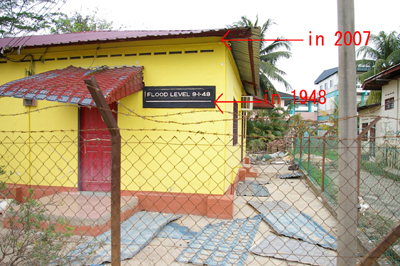 Flood Marks
on the wall of gate keepers office at DID
Flood Marks
on the wall of gate keepers office at DID
in Kota Tinggi |
|
| |
11.
"Typhoon Committee Hydrological Component Workshop for the Exchange of Technology
on Evaluation and Improvement of Flood Forecasting System" (Feb.5-7, South
Korea)
his workshop was conducted by the Korean Ministry of Construction
and Traffic on behalf of Typhoon Committee, Hydrological Component of the World
Meteorological Organization (WMO), and United Nations Economic and Social Commission
for Asia and the Pacific (ESCAP). As an expert of this research field, Mr. Fukami,
the leader of Hydrologic Engineering Research Team, reported the present conditions
of flood. forecasting system and technology in Japan. In this workshop, participants
hold an active discussion about a policy for the improvement of performance evaluation/management
system for flood forecasting system called MOFFS (Management Overview of Flood
Forecasting System), on which Korea put special emphasis.
|
| |
12.
"East & Southeast Asia Regional Seminar on Flood Hazard Mapping",
2007 (Feb.7-9, Malaysia)
"East & Southeast Asia Regional
Seminar on Flood Hazard Mapping" was organized by International Centre for
Water Hazard and Risk Management, Public Work Research Institute (ICHARM/PWRI)
in close cooperation with Japan International Cooperation Agency (JICA) and Department
of Irrigation and Drainage (DID), Malaysia. The event was held from 7th to 9th
February, 2007 in Renaissance Hotel Kula Lumpur. The main objective of the seminar
was to provide the platform for former participants of Flood Hazard Mapping (FHM)
training course to share their knowledge and experience through interactive participation.
Selected participants were professional engineers from governmental organizations
working actively in flood disaster management in their home countries. The
seminar concentrated on the issues of flood hazard mapping and its field application
as a tool for disaster preparedness and mitigation. All together 25 participants
including 8 local participants those selected by DID, Malaysia have taken extensive
benefits from the seminar, sharing theoretical and practical knowledge and achieving
hands-on experience with field visits in one of the flood affected areas in Kuala
Lumpur, Malaysia. Presentations from participants covered range of aspects such
as case study, work progress, current issues, future challenges etc. In addition,
invited lecturers from selected international organizations gave insights on latest
technology and methodology for the development of flood hazard map. The
seminar was inaugurated by the Deputy Minister of Natural Resources and Environment
H.E. Mr. S. Sothinathan. Several high ranking officials from different governmental
organizations of Malaysia were also present in the opening ceremony. In the occasion,
the deputy minister and the Director General of DID expressed their interest to
cooperate with ICHARM for long term cooperation in the field of water induced
disaster management in Malaysia, of which southern part especially Johor state
was seriously affected by the flood in December 2006 and January 2007. Mr. Terakawa,
the acting director of the ICHARM expressed his appreciation to all participants
and thanks to co-organizers for their supports to make the event successful and
effective. And, also, two Dr. Manzul Hazalika, Asian Institute of Technology(AIT)
and Dr. Arun B. Shrestha, International Centre for Integrated Mountain
Development(ICIMOD) were invited as resource persons and gave the presentation
titled by "Capacity Building in Applications of Geoinformatics in Flood Hazard
Mapping" and "Flash floods in the Himarayas and vulnerability analysis". Similar
kind of workshop will be organized by ICHARM in 2008 with the involvement of most
former participants of FHM training course and representatives from several international
organizations and research institutes from around the world. The event and
the comments from deputy minister were highlighted in most local newspapers.
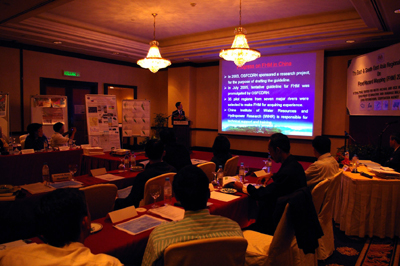
Presentation of ex-trainees | 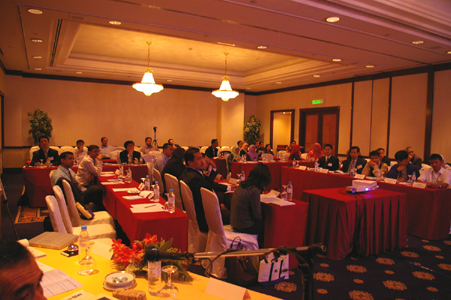 at the seminar
at the seminar |
 |

Flood hazard map in Malaysia and Thailand | |
| |
13. OIC-Director
Cabral and two officials from the Philippines visits ICHARM (Feb.8, Tsukuba, Japan)
Dr. Cabral and two other officials from the Philippines visited ICHARM on 8th
February, 2007. They were invited by JICA to implement the Philippine-JICA study,
"the Nationwide Flood Risk Assessment and the Flood Mitigation Plan for the
Selected Areas in the Republic of the Philippines". The three visitors were
Dr. Maria Catalina E. Cabral (OIC-Director, Planning Service, Department of Public
Works and Highways), Mr. Philip F. Menez (Project Director, Project Management
Office of Major Flood Control and Drainage Projects-Cluster II, Department of
Public Works and Highways), and Mr. Freddie M. Combalicer (Engineer, Quezon 1st
District Engineering Office, Region IV-A, Department of Public Works and Highways). The
survey is conducted to collect and to organize natural and social conditions and
past disaster records regarding 18 large river basins and 403 small and medium
river basins throughout the Philippines. Based on the data collected, risk assessment
will be conducted for each basin of the country, and proposals will be made suggesting
effective structural and non-structural flood control measures for river basins
assessed to be of high risk. Over the past 30 years, the Government of
Japan provided intensive support to large-scale flood control projects for 18
large-size rivers in the Philippines. However, now emerging is a strong demand
for low-cost and effective flood control measures targeting small- and medium-sized
rivers. In addition to tight financial conditions, there are more and more cases
in which politically and financially important cities are located in the inland
areas of small- or medium-sized rivers. In recent years, the Philippines is aggressively
promoting the integrated water resource management and the river basin management.
The Philippine officials visited ICHARM in this context to have a better understanding
over stakeholder coordination systems, including procedures to formulate river
development plans, about which Japan has accumulated a great deal of knowledge. In
addition, there are still a large number of rivers without levees in the Philippines,
which resembles the time before modern flood control was introduced to Japan.
Because of that, ICHARM also provided them with information on traditional flood
control planning and technology, such as flood defense methods, utilization of
reservoirs, groins, and open levees. | |
|
14. "The
1st Meeting of the Asia Pacific Water Forum Governing Council" (Feb.21-22,
Singapore)
"The 1st Meeting of the Asia Pacific Water Forum
Governing Council" was held on 21st to 22nd February 2007 in Singapore under
the chairpersonship of Mr. Tommy Koh, an ambassador-at-large. The meeting approved
three priority themes for the Asia Pacific Water Summit in December 2007 in Beppu,
Oita, Japan. These three themes are as follows: 1) Water Financing, 2) Water-related
Disaster Management, and 3) Water for Development and Ecosystem. Also, the meeting
concluded that ICHARM should be the lead organization in water-related disaster
management. By the December summit, ICHARM plans to compile a thematic report
to make a political appeal with supporting arguments regarding the issue after
deepening discussions through the water weblog of the Asia Pacific Water Forum
(http://www.apwf.org/).
Dr. Tarek Merabtene is in charge of the water weblog. Anyone who is interested
in the issue will be welcome to join the discussion. |
| |
15. "Hydrology
delivering Earth System Science to Society", HESSS (Feb.28-Mar.2, Tsukuba,
Japan)
A three-day international symposium on "Hydrology
delivering Earth System Science to Society" was held at the Tsukuba
Congress Center from 28th February to 2nd March. The symposium was supported by
a research project called "Leadership on the Hydrological Science for Mitigating
World Water Issues" (led by Prof. Taikan Oki of the Institute of Industrial
Science, the University of Tokyo) under the Leadership for International Scientific
Cooperation program, part of the Special Coordination Funds for Promoting Science
and Technology. The purpose of the symposium was to discuss a broad range
of issues on modeling technology including latest modeling technologies, future
directions of modeling technology development, how to fill gaps between social
expectations to and the current development level of modeling technology. ICHARM
participated in the symposium as one of the organizers, and several ICHARM researchers
made presentations respectively. Dr. Takeuchi, Mr. Terakawa and Dr. Merabtene
made oral presentations and Dr. Hapuarachchi, Dr. Osti, and Mr. Inomata gave poster
presentations.
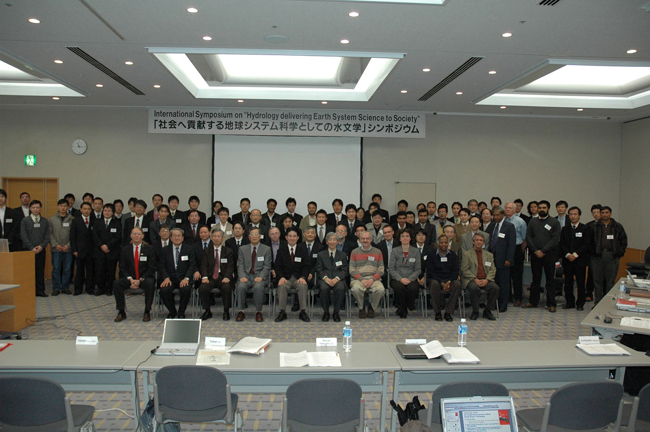
Participants at symposium
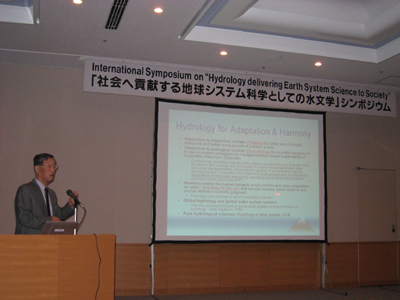
Dr. Takeuchi at presentation | |
| | |
Information
I CHARM newsletters are distributed via e-mail. They can also be
downloaded from our website. To subscribe or unsubscribe to our mailinglist, please
contact us via e-mail. We welcome any comments or requests from you to help us
make this newsletter more effective and informative.
Issued by: International
Centre for Water Hazard and Risk Management under the auspices of UNESCO (ICHARM)
1-6 Minamihara Tsukuba Ibaraki 305-8516, Japan Tel: +81-29-879-6809
Fax: +81-29-879-6709
e-mail: icharm@pwri.go.jp URL: http://www.icharm.pwri.go.jp/
|
| |





